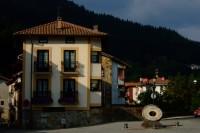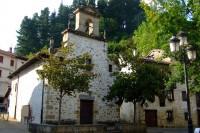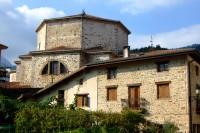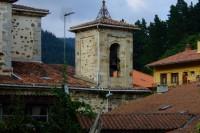In this northern Spain, the fine days for biking don’t last long, and one has to make good use of the remaining summer. Yet, it’s convenient to wisely choose the course to be taken, so as to make the best of the climate. Therefore, I check the weather forecast, mainly the winds, and accordingly I set my route for today in the map.
For these short outings I’d rather take my jet helmet, as far as the weather permits. I know it’s less safe, but… it gives me such a freedom!
For the first kilometres I ride along a double laned motorway, good for warming up: same Rosaura and me. Later on, I turn off a secondary road with no signs at all, though well paved. The fun starts now. First I gain elevation along hills and brows, lined by a reservoir’s blue waters to my left and green woodlands to my right. As I get higher, the view to the water becomes landscape. Then, the road goes into the forest and, for a while, runs under a thick roof of shady beech groves, centennial oakwoods and dense pines, patched here and there with a small meadow. In this ground, the bends are as unpredictable as the wild deer crossing the road, so there’s no hurrying, and I take the chance for enjoying the woods and let them take me to a pure and distant time.
Out of the blue, at the turn of a bend, the forest clears up and all of a sudden a scenery appears before me that knocks my spirit with its beauty, forcing me to an abrupt brake to behold it. It’s Aramayo, an astonishing and idyllic valley; one of those nostalgic Arcadys of these Basque mountains, made of green lively pastures, golden stubble fields, dark woods, lost hamlets, and surrounded by blueish mountains. Down, in the botton, behind a hillock protrudes the village of Ibarra.

The hidden valley of Aramayo.

One of the hamlets of the Zula bunch.
Beyond the mountain pass, as I descend towards the valley along the steep and winding road, Aramayo bewitches me more and more. This corner of the planet smells to wet soil and dairy cows, to hey and cow pat, to the countryside of an harmonic preindustrial era. It’s a captivating place. By the sole strength of its purity, it’s hard to believe that this could have been the hometown of the wrathful Lope de Aguirre, the Spanish conqueror, as some historian claims.

Spread out helmets.
As soon as I enter Ibarra, I feel observed with mistrust. Perhaps because I’m in one of the bastions of the basquism (all independence and vindicating flags), where every outsider can be a foe; or perhaps it’s just my suggestion. I park the bike and, as I use, I get inside the narrow streets of the village searching for pictoresque corners. On watching me passing by back and forth, a local addresses me in Basque, in an interrogating tone. I point at my camera and say: “tourism”. Then he replies in Spanish: “Interior or exterior tourism?”. I wonder what the heck he’s meaning. “Just tourism”, I answer.

Chapel at Ibarra’s gate, medieval origin, refurbished.
On the banks of Aramayo river, which names the valley, and under the towering church of San Martín (XIXth c), Ibarra has been perhaps, up to thirty or fourty years ago, a an inmaculate and lyrical village, with pastoral grace and edenic charm: thus we can imagine by the layout of the bent and narrow streets, the traditional houses, evoking of yore, the medieval chapels, the terraced gardens and even the stream of singing waters that crosses the hamlet.
-

- Ibarra
-

- Ermita en la plaza del pueblo.
-

- Parroquia de San Martín de Zalgo, neoclásica.
-

- Campanarios de San Martín.
But the forges and, with them, the industrial prosperity arrived here, certainly, before the urban bylaws had time to set bounds to construction, and nowadays half of the village has been spoiled by ugly, discordant and heterogeneous blocks of flats.
I finish my surbeying the place and look for a tavern where to fulfill my gastronomic ritual, a beer and a tapa; but I only see two bars, of a modern look and full of a noisy youth that doesn’t appeal to me. So, I let it be this time. Maybe next. Rosaura is awayting me by the pavement and I sit astride her with a kind of complicity feeling, as if she could understand me. I turn on the engine and pass discretely by the bars, arising some stares. No matter how hard I try, this motorbike never passes unnoticed. When I get to the junction, I open gas and return, up the hill, up the bends, eagerly inhaling the smell of the hey. Along the way I run into a bunch of bikers, but no one waves at me. Are we losing the good habits?
Upon arriving to the pass I halt again and take a last look over this miraculous and anachronistic Arcady, like those described by a Spanish writer. Despite my intentions, I wonder if I’ll ever come back.

Farewelling Arcady.





